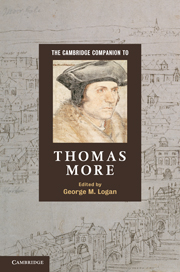Book contents
6 - The last years
from Part I - Life, times and work
Published online by Cambridge University Press: 28 May 2011
Summary
At around three o’clock on 16 May 1532, Thomas More met with the king in the garden of Cardinal Wolsey’s former dwelling, York Place, near the palace of Westminster, and handed him a white leather pouch containing the Great Seal of England. More’s resignation as lord chancellor marked an end and a beginning. A distinguished public career as a lawyer in royal service had come to a conclusion. Yet the final three years of Sir Thomas’s life would be characterized by waves of intense activity and accumulations of dramatic incident – they would define the meaning of that life for posterity, supplying the lens through which More’s character and motives must inescapably be read. Whether either of the old friends possessed any inkling of this that Thursday afternoon in Westminster is unknowable. Sir Thomas, declaring himself not equal to the responsibility, presented his stepping down from office as a withdrawal from the cares of the world, asking leave ‘to bestow the residue of my life in mine age now to come, about the provision for my soul in the service of God, and to be your Grace’s beadsman and pray for you’. Henry, for his part, graciously promised More ‘that in any suit that I should after have unto your Highness, which either should concern mine honor … or that should pertain unto my profit, I should find your Highness good and gracious lord unto me’ (SL 202). None of these undertakings were in the event to be honoured.
- Type
- Chapter
- Information
- The Cambridge Companion to Thomas More , pp. 116 - 138Publisher: Cambridge University PressPrint publication year: 2011

